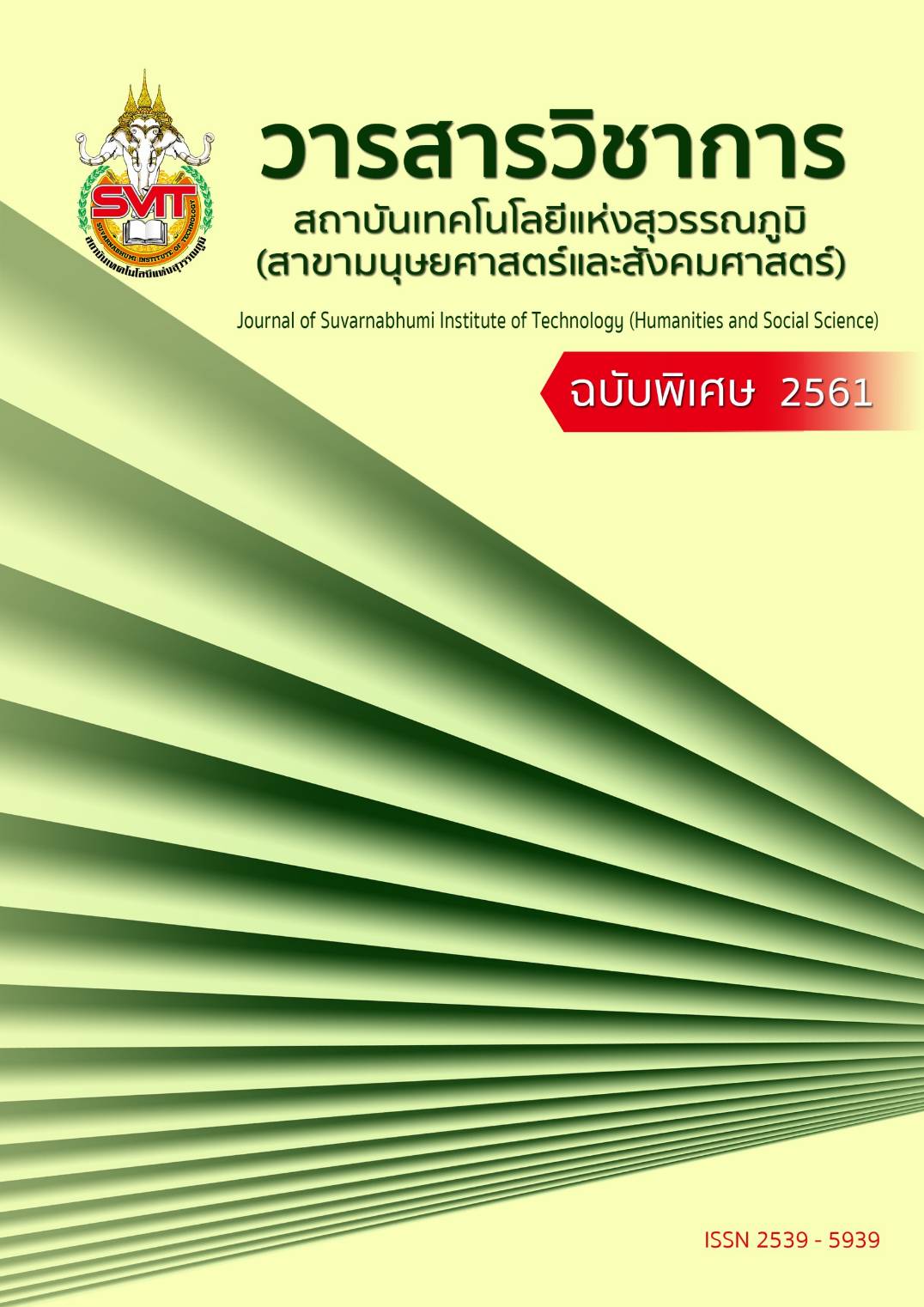MARKETING STRATEGY AFFECTING TO THE EFFECTIVENESS OF DECISION TO STUDY A TUTOR SCHOOL ON MARKETING MIX
Keywords:
Strategic Marketing Services, Product Innovation, tutor schoolAbstract
The purposes of this research were: The method of research was used quantitative research and qualitative study. The samples for this study were 400 persons of students interested in studying the tutorial school. Key informants for interviews. There are 8 entrepreneurs in the tutor school. The research instruments were check list form and semi-structured interview that had been tested the validity and reliability. Descriptive statistics and inferential statistics were such as percentage, mean, standard deviation, and multiple regression analysis. Qualitative analysis using content analysis.
- Factors Behavior Learning Tutor It consists of the following elements: 1) Service marketing strategy consists of 8 components: product, price, place, promotion, marketing, personnel. Physical characteristics process 2) Product innovation consists of 4 components: online learning and online marketing. Digital marketing. Development of teachers and service personnel. It also expanded the curriculum for elementary school children and adults to prepare them for the AEC. At the .01 level of significance
- Influence of Service Marketing Strategy Factors Product innovation strategy Affecting School Decision Making At the .01 level of significance
- The service marketing strategies for tutoring Schools. It consists of the following elements: 1) The product/service has a variety of teaching courses and features. 2) The price is appropriate and there may be an increase in tuition fees due to the tax costs. 3) Distribution or Place in urban centers and department stores. 4) Marketing Promotion, reduced tuition fees for former students who want to repeat the course. 5) The staff has a tutor with expertise. 6) Physical characteristics, the convenience of the students, the equipment is fully equipped. 7) Process, Off school teaching. And 8) Show the student achievement statistics of the past. For the strategy of product innovation. 1) Online learning. 2) Development of learning media. 3) Development of teachers has developed into the modern age. 4) Extend the curriculum for elementary school children up to adolescents in order to prepare for AEC, especially for ASEAN Languages. To conduct international business.
References
ธธีร์ธร ธีรขวัญโรจน์. (2556). การตลาดบริการ. กรุงเทพฯ: ซีเอ็ดยูเคชั่น.
ปัณชญา ทับจันทร์. (2555). ปัจจัยทางการตลาดในการเลือกโรงเรียนกวดวิชาของนักเรียนระดับมัธยมศึกษา ในเขตอำเภอเมือง จังหวัดสุราษฏร์ธานี.
วารสารวิชาการมหาวิทยาลัยธนบุรี 8(17) (2014): กันยายน – ธันวาคม 2557 หน้า 31-43.
ไพฑูรย์ สินลารัตน์. (2560). ก่อนถึงโรงเรียน 4.0 : โรงเรียนสร้างสรรค์. (พิมพ์ครั้งที่ 6). กรุงเทพฯ: วิทยาลัย ครุศาสตร์ มหาวิทยาลัยธุรกิจบัณฑิตย์.
รุ่งศิริ อภิชิตพงศ์ชัย. (2555). การวิเคราะห์ด้านการบริหารที่ส่งผลต่อการตัดสินใจเลือกสถาบันสอนพิเศษด้านวิทยาศาสตร์ของกลุ่มนักเรียนระดับชั้นมัธยมศึกษา ในเขตอำเภอศรีราชา จังหวัดชลบุรี. งานนิพนธ์การศึกษามหาบัณฑิต, สาขาวิชาบริหารธุรกิจ, บัณฑิตวิทยาลัย, มหาวิทยาลัยบูรพา.
วุฒิพงษ์ ภักดีเหลา. (2554). การศึกษาคุณลักษณะขององค์การนวัตกรรม : กรณีศึกษาองค์การที่ได้รับรางวัลด้านนวัตกรรม. วิทยาศาสตรดุษฎีนิพนธ์ สถาบันบัณฑิตพัฒนบริหารศาสตร์.
ศิริวรรณ เสรรีรัตน์ และคณะ. (2556). กลยุทธ์การตลาดการบริหารการตลาด. กรุงเทพฯ: ธีระฟิล์มและไซเท็กซ์.
ศูนย์วิจัยกสิกรไทย. (2557). ตลาดกวดวิชายังคงเติบโต : จับตา ทางเลือกกว้างขึ้นของนักเรียน และสินค้าติวเข้ามหาวิทยาลัย เป็นปัจจัยท้าทาย. เข้าถึงเมื่อ 1 มีนาคม 2561. จาก https://positioningmag.com.
สำนักงานคณะกรรมการศึกษาแห่งชาติ. (2555). พระราชบัญญัติการศึกษาแห่งชาติ พ.ศ. 2542. กรุงเทพฯ: มิตรสยาม
อาทิตยา พนาเจริญไพบูรณ์. (2555). กลยุทธ์การดำเนินงานที่มีผลต่อกระบวนการตัดสินใจของผู้ปกครองในการนำบุตรหลานเข้าศึกษาในโรงเรียนอนุบาลเมืองใหม่ชลบุรีสังกัดองค์การบริหารส่วนจังหวัดชลบุรี. งานนิพนธ์การศึกษามหาบัณฑิต, สาขาบริหารธุรกิจ, บัณฑิตวิทยาลัย, มหาวิยาลัยบูรพา.
Camisón, C. & Monfort-Mir, V. M. (2012). Measuring innovation in tourism from the Schumpeterian and the dynamic-capabilities perspectives. Tourism Management, 33, 776-789.
Drejer, I. (2004). Identifying innovation in surveys of services: A Schumpeterian perspective. Research Policy, 33(3), 551-562.
Kotler, P. (2009). การจัดการการตลาด. (ธนวรรณ แสงสุวรรณ และคณะ, แปล). (พิมพ์ครั้งที่ 11). กรุงเทพฯ: เพียร์สัน เอ็ดดูเคชั่น อินโดไซน่า.
Lovelock and Wirtz. (2007). Service Marketing, People, Technology, Strategy. 6th ed. Pearson International Education, pp.22, pp.207, 380.
Downloads
Published
Issue
Section
License
บทความที่ได้รับการตีพิมพ์เป็นลิขสิทธิ์ของวารสารวิชาการ สถาบันเทคโนโลยีแห่งสุวรรณภูมิ
ข้อความที่ปรากฏในบทความแต่ละเรื่องในวารสารวิชาการเล่มนี้เป็นความคิดเห็นส่วนตัวของผู้เขียนแต่ละท่านไม่เกี่ยวข้องกับสถาบันเทคโนโลยีแห่งสุวรรณภูมิ และคณาจารย์ท่านอื่นๆในสถาบันฯ แต่อย่างใด ความรับผิดชอบองค์ประกอบทั้งหมดของบทความแต่ละเรื่องเป็นของผู้เขียนแต่ละท่าน หากมีความผิดพลาดใดๆ ผู้เขียนแต่ละท่านจะรับผิดชอบบทความของตนเองแต่ผู้เดียว





